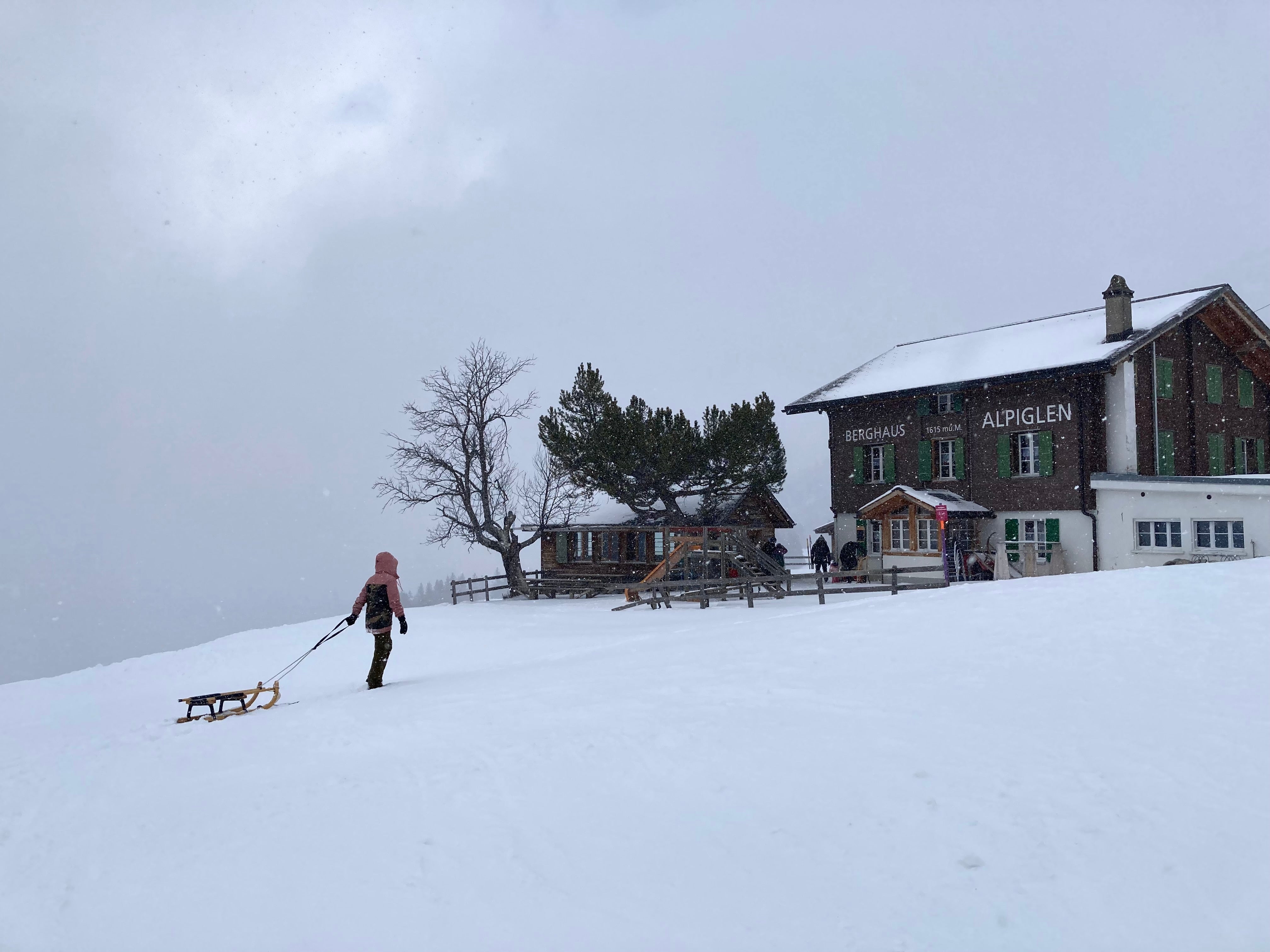On the green run: A ski-free winter break to Switzerland’s eco-focused Jungfrau region
As it speeds towards sustainability and embraces low-impact sports, this Swiss gem is setting a shining example for a cleaner, greener future of winter tourism in the Alps, says Kerry Walker

Your support helps us to tell the story
From reproductive rights to climate change to Big Tech, The Independent is on the ground when the story is developing. Whether it's investigating the financials of Elon Musk's pro-Trump PAC or producing our latest documentary, 'The A Word', which shines a light on the American women fighting for reproductive rights, we know how important it is to parse out the facts from the messaging.
At such a critical moment in US history, we need reporters on the ground. Your donation allows us to keep sending journalists to speak to both sides of the story.
The Independent is trusted by Americans across the entire political spectrum. And unlike many other quality news outlets, we choose not to lock Americans out of our reporting and analysis with paywalls. We believe quality journalism should be available to everyone, paid for by those who can afford it.
Your support makes all the difference.As morning commutes go, this one wins. As I glide noiselessly above a Christmas card scene of spruce forest, log chalets and a smooth blanket of fresh snow, Eiger feels close enough to slam into should the wind suddenly change. The first sun is creeping down its North Face. Though a shade off the magic 4,000-metre mark at 3,967m, this Swiss mountain is a beast: feared and revered for its vertical wall of rock and ice that has broken many a rock climber’s rope and soul.
That you can reach the mountain at all is a wonder. That you can now whizz up there on a tri-cable gondola in just 15 minutes from Grindelwald is a stroke of Swiss genius. When the Eiger Express opened in December 2020, it carved 47 minutes off the journey to Europe’s highest railway station, Jungfraujoch, with an elevation of 3,454m. It set a precedent for ecofriendly mountain transport. The Eiger Express uses its wheels to generate green power and has its own heat recovery system. The landscape is pristine and the aim is to keep it that way.
“When overseeing the construction of the cableway, I looked at how we could minimise impact and enhance habitat,” says environmental supervisor and agronomist, Martin Lutz. The idea was for the gondola to slot into the landscape unobtrusively, so Martin’s job has been to protect the surrounding environment, involving everything from creating ponds to prevent erosion and attract species like midwife toads, to recultivating soil, making forest clearings more natural, collecting seeds, rewilding meadows and planting sycamore trees.

At Eiger Glacier, where the gondola ends and a little red train takes over, I pause to peer out across a glacier spilling down the mountainside like crushed meringue before boarding the Jungfraubahn. Trundling up to Jungfraujoch since 1912 and celebrating its 110th anniversary this year, the railway has always been ahead of the game. It was powered by hydroelectricity from the outset.
At the top, it is quieter than usual, and I find myself briefly alone in the shimmer of the Ice Palace, which mountaineers hacked out by pickaxe in the 1930s. From the terrace, the view reaches across a ripple of pearl-white 4,000m peaks and the 23km twist of the Aletsch Glacier, the longest glacier in the Alps, now sadly retreating. It’s a clear day. Where the Swiss Alps fizzle out, Germany and France appear like pencil smudges of green in the distance.
“The Unesco World Heritage Jungfrau-Aletsch region is unique and it’s our job to preserve it for future generations,” says Jungfrau Railways spokesperson Kathrin Naegeli. “Our projects pay close attention to the wildlife and habitat, reducing energy consumption and improving biodiversity, setting up conservation areas and funding research. Some villages, such as Wengen and Murren, are car-free and can only be reached by public transport. Some railways, for instance, the Jungfrau and Wengernalp lines, use brake energy to generate new electricity.
It’s a clear day, the sky piercing blue. Where the Swiss Alps fizzle out, Germany and France appear like pencil smudges of green in the distance
“We want to encourage people to explore in a slower, calmer, greener way.”
A cornerstone of this approach is diversification. Skiing has traditionally had a bad rep on the environmental front, but the Jungfrau region mitigates this by offering low-impact alternatives away from the pistes.
I dive in the deep end with my partner and two-year-old daughter, grabbing a toboggan and whooshing down the Eiger Run from Eiger Glacier to Kleine Scheidegg – no ski school or fancy gear required. The region’s big three, Eiger, Monch and Jungfrau, glower down as we swoop bends, collide with snowdrifts, pick up speed in forests sculpted with hoarfrost and stop, ruddy-cheeked, at timber huts for rosti and hot chocolate. It’s tremendous, childish fun. Reach the end and you’re itching to do the whole thing again.
And we do. In Wengen we hit the fox run, pinballing down the mountain to the village as a snow blizzard snuffs out the view and paints everything white. We pause to build snow creatures in silent woods, admire icicles, breathe in the crystal air and catch perfect snowflakes – things you’d never even consider doing when skiing.

The next day we make for Kleine Scheidegg to rent a velogemel, the region’s one-of-a-kind wooden ski-sledge-bike hybrid. Invented by a carpenter from Grindelwald in 1911 to make getting around the Alps easier for everyone from postal workers to doctors, the contraption now has cult status and its own world championships in February. The thing looks utterly terrifying, but after playing with it for a few wobbly minutes, I get the knack and fly down the mountain, frantically digging in my heels to brake.
Grindelwald is also the starting point for a gondola ride up to First, where thrills come in the shape of feet-first (First flyer) and head-first (First glider) ziplines racing towards Eiger North Face. But for an away-from-the-crowds adventure, we choose the tough uphill hike to Faulhorn instead, tugging sledges for two-and-a-half hours through the snow to reach Big Pintenfritz, Europe’s longest toboggan run at 15km. Opening up sensational views of the Bernese Alps, the dash through forests and down steep slopes leaves us frozen, aching and exhilarated.
Hotel Glacier is our Grindelwald base. Named after the Lower Grindelwald Glacier, which has retreated so rapidly in recent years it is no longer visible from the valley, the 28-room boutique hotel is a stylish revamp of a traditional Alpine chalet. There’s an intimate spa and glacier-themed rooms with neo-rustic designs and a palette of silvers and blues. Some rooms come with hot tubs echoing the contours of the mountains. And it’s all ecofriendly. Materials are natural and sustainably sourced, waste is minimised and energy comes from the local biomass plant.
The sun breaks over the mountains as we float up to the summit, gasping as the gondola sheers ice from the cables and swings close to huge fists of rock
The hotel’s restaurant is the clincher, with a clever tasting menu that takes pride in local sourcing – so much so that head chef Robert Steuri has drawn up a map pinpointing produce, from Grindelwald beef to Lake Zurich mussels. Dishes like smoked sturgeon with Swiss caviar and kohlrabi and braised Swiss wagyu with black truffle and egg-yolk praline are flawlessly cooked and presented.
Our final day ends on another high at Piz Gloria at the top of Schilthorn, which featured in the 1969 Bond film On Her Majesty's Secret Service. The sun breaks over the mountains as we float up to the summit, gasping as the gondola sheers ice from the cables and swings close to huge fists of rock. We’re among the first visitors of the day for brunch at the solar-powered revolving restaurant, where views sweep over the Alps.
As glorious as the summits are, sometimes the hidden places leave the most lasting impression. And so it is when we descent to Murren, putting on snowshoes to pad high above the log chalets and into the spruce forest, which occasionally draws back like a curtain to reveal front-row views of the Jungfrau massif.

“Alpine hare prints,” whispers Anita Rossel, a guide with Bergfalke Alpine School, pointing out a thin track in the snow as we pick our way along a trail whipping up to the moorland nature reserve of Chänelegg. As we head up and over the hilly plateau beneath a pale winter sun, the chat turns to her avalanche-trained sheepdogs, the impact of climate change on snow levels and the ecofriendly winter activities she offers, such as igloo building. But mostly we walk in companionable silence, with just the crunch of snow underfoot and Eiger on the horizon.
Travel essentials
Getting there
Trying to fly less?
The region is brilliantly connected to the rest of Europe by train, and Swiss ones are very ecofriendly, drawing 90 per cent of their energy from hydropower.
Fine with flying?
If you decide to fly, SWISS fare the best environmentally, with firm goals for slashing CO2 emissions and having carbon offsetting schemes.
Staying there
Doubles at the four-star Hotel Glacier from £244. hotel-glacier.ch
More information
Mountain transport takes over once you reach Interlaken. Two handy, money-saving passes worth investing in are the Swiss travel pass and Jungfrau travel pass.
Join our commenting forum
Join thought-provoking conversations, follow other Independent readers and see their replies
Comments